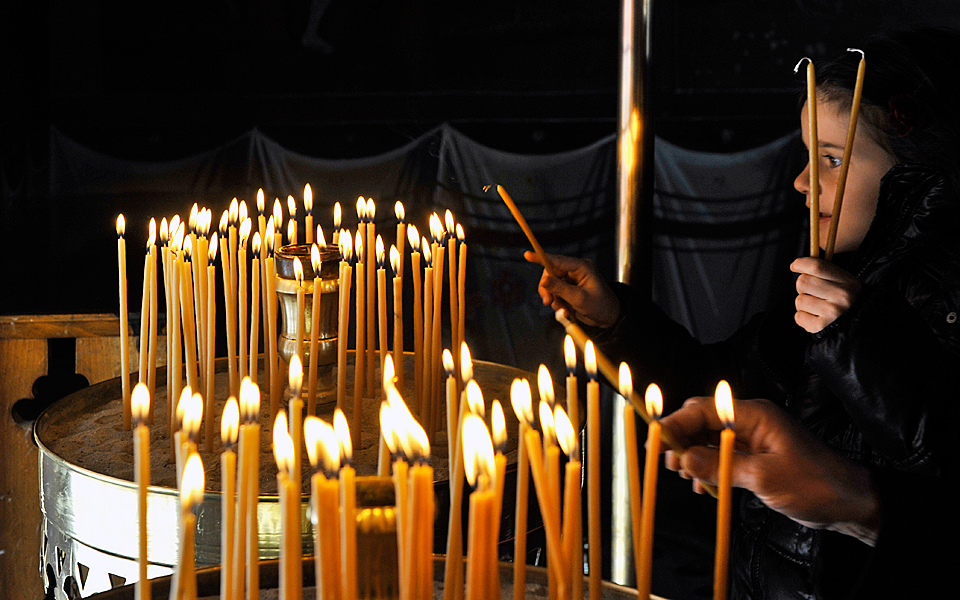
Life
Your Sunday Best
A mini guided tour of the Greek Orthodox Sunday Mass and etiquette.
One Sunday last month, I decided to head to downtown Athens to Aghia Irini church on Eolou St to attend mass. I’d been informed that if I wanted to experience the mass in all its glory, then this was the ideal church to go to. The voices of the chanters are said to be pitch-perfect, while Father Thomas observes the entire ritual virtually unaltered, without any short cuts. In addition, the church itself holds an important place in Greek history as it served as the city’s first cathedral when, in 1834, under King Otto’s rule, Athens replaced Nafplio as the newly liberated country’s capital city. The nearby Metropolitan Cathedral of Athens, constructed over the next few decades, eventually assumed this leading role.
I arrive at Aghia Irini church, located at the square of the same name, at 07:00. The plateia is one of the city’s most vibrant spots. In a few hours time, its cafes will have filled to the brim with people enjoying coffee and Sunday brunch. Besides the chanters and priest, already at work inside the church, there is not a soul to be seen when I get there.

The Aghia Irini church on Eolou St.
Upon entering an Orthodox church, the faithful usually light a candle as a symbolic offering of sacrifice to God. They then bow their heads at the icons, kissing them in a gesture of respect and love towards the figure depicted – Jesus, the Virgin Mary or the saint to whom the church is dedicated, in this case Saint Irene.
I step inside and begin adjusting to the surrounds. The congregation is currently comprised of just one male and me. It is awfully early – truth be told – and the liturgy is only getting underway. Sunday’s Holy Communion service proper does not begin until roughly 08:15. A young lady wearing a mini skirt and high heels enters the church hastily. She lights a candle, blesses herself and kisses the icon three times. I observe where she will go next as I suspect men and women sit on separate sides of the church. If so, I should follow in her direction. She heads to the left and so do I. Later on, I was officially informed that men and women do sit separately, but that the requirement is not observed as stringently as in the past. There was a time when women were not permitted to sit in the main section of the church. Instead, a special area was designated for females up in the gallery so that they would not corrupt the minds of men with their presence, or break the concentration with … customary chatter.
Whether male or female, I recommend that you choose a place at the back, towards a side, and discreetly observe the service’s proceedings. As you will realize, this too, like any other performance, is a somewhat choreographed ritual. The faithful go about standing, sitting, bowing and blessing themselves at specific points throughout the service. Similarly to the chorus of an ancient tragedy, the chanters address themselves to God on behalf of the faithful by recalling the life of Christ, from birth to resurrection, through the delivery of hymns and Byzantine psalms. The priest, serving as an intermediary between God and the people, primarily assumes the role of preparing the faithful for Holy Communion, their symbolic union with Christ, through a series of prayers and procedures, such as the blessing of the bread and wine.
At the sound of the third bell (something like the third buzzer at the theater), the faithful have hopefully gathered and the Holy Communion service may commence. Its first part is directed at individuals who are not baptized Christians and, besides prayers, it includes readings from the Gospel for the day, followed by a sermon. At this specific church, the readings are offered following Holy Communion. This may be the case because the priest wants to ensure that the entire congregation is present for the sermon. The second part of the service is usually intended only for baptized Christians, while all others are requested to leave. This does not necessarily mean that outsiders must leave no matter what. Visitors may carry on discreetly observing from the side as the service reaches its climax. In the Orthodox Church, as in most Christain churches, Holy Communion is conducted through the transubstantiation of bread and wine into the body and blood of Christ. You will see the priest mix the two in a glass and add hot water to warm up the wine to the temperature of blood, but not before asking the Holy Spirit to transubstantiate the bread and wine into Christ’s body and blood. Then, the congregation slowly queues up for Communion – men to the right, women to the left. Everyone present, from the elderly to the youngest of children, are offered communion with the same spoon. Don’t be surprised. Faith ensures immunity…
Once the service has ended, the priest offers the faithful a piece of the blessed bread after they have kissed his hand. In Greek, the bread is known as the antidoro, meaning “gift substitute.” In the past, only individuals who could not receive communion for reasons such as illness were entitled to the blessed bread. Nowadays, every member of the congregation takes a piece. Some choose to take more. Perhaps they believe that the greater the number of pieces taken, the greater the overall blessing received.
This is, more or less, how the Greek Orthodox Church’s Holy Communion service ends. At Aghia Irini, people remain in the church following the liturgy. While the chanters are still gathering various items and sextons are turning off lights, members of the congregation gather up in the gallery for breakfast that includes hot beverages and snacks. They are soon joined by the chanters and priest. Laughing, teasing and children’s voices becomes audible as the Sunday service concludes in a more festive and secular spirit. Subsequently, relocating from inside the church to the square, which, by this stage, has begun filling with people, becomes a smoother transition.
INFO | Aghia Irini church, 36 Eolou, tel. (+30) 210.322.6042 (Father Thomas or Father Artemios). Sunday mass 06:40–10:30 (with the communion service beginning at 08:15).
I would like to thank Father Filotheos at Agios Pavlos church (38 Chiou, Platia Vathis) who helped me gain an understanding of the Holy Communion service.







